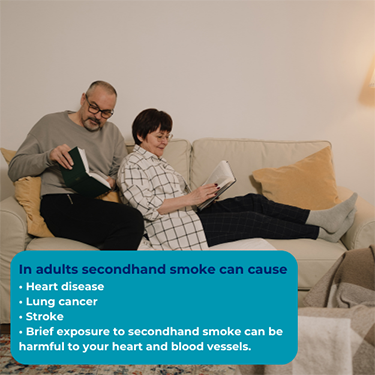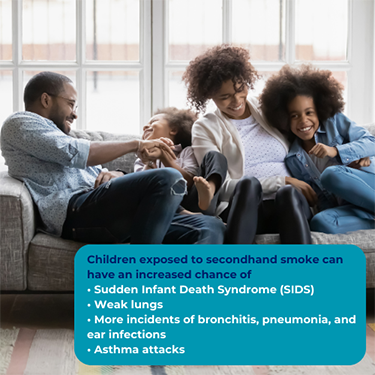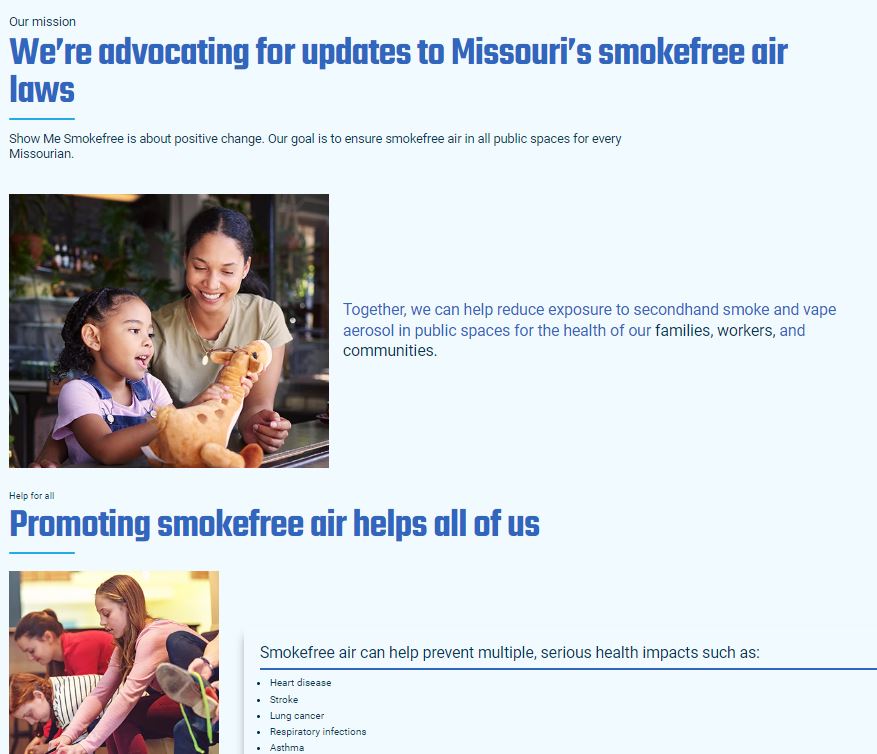Smoke-Free Environments
New Website Launch
Explore our new campaign website to help Missourians advocate for healthier public spaces and workplaces
What are the benefits of smoke-free policies?
- Protect people from secondhand smoke and e-cigarette aerosol.
- Prevent youth from starting tobacco use.
- Help people quit and stay quit.
- Protect people from thirdhand smoke, the toxic residue left behind from tobacco smoke
Model Policies and Tobacco-Free Resources
Find example policies, step by step guidance, handouts, infographics, and other resources for going smoke-free in any setting.
Why is secondhand smoke and aerosol a problem?
- Most Missourians are not protected by smoke-free policies at work and at home.1
- The only way to fully protect people from secondhand smoke is to eliminate smoking in homes, worksites, and public places.2
- Ventilation systems, barriers, and separate smoking areas do not protect people from secondhand and thirdhand smoke.3
- Tobacco smoke can be measured in high quantities more than 20 feet from an outdoor source.4


What about secondhand aerosol from electronic devices (vaping)?
- Secondhand aerosol is exhaled, or breathed out, by people using electronic smoking devices.
- Many of the long-term health effects of aerosol from electronic devices are still unknown, but we do know that it contains chemicals that are harmful to inhale.6
Secondhand aerosol contains
- Nicotine
- Ultrafine particles that irritate asthma and other lung conditions.7
- Cancer causing toxins.8
- Propylene glycol which can cause asthma in children.9
- Chemicals that cause permanent damage to the airways and lungs.10
What about smoke and aerosol from cannabis (marijuana)?
- Secondhand marijuana smoke contains many of the same toxic chemicals found in tobacco smoke.
- Chemicals in secondhand marijuana smoke can cause lung cancer.11
- Children who have caretakers or live with people who smoke cannabis have detectable levels of THC (marijuana’s compound that causes a high) in their bodies.12
- More research about the effects of secondhand marijuana smoke is still needed.12
What is thirdhand smoke?
- Thirdhand smoke is the residue, smell, and staining left behind from cigarette smoke for months after smoking has stopped.
- Routine cleaning methods do not remove thirdhand smoke.
- Thirdhand smoke contains 250 chemicals and sticks to dust, carpets, upholstery, walls, hair, clothes, pets’ fur, and feathers.
- The toxic chemicals left behind can re-emit and off gas back into the air.13,14
- Babies and children absorb thirdhand smoke through their skin when they crawl on contaminated floors and ingest it when they put contaminated items in their mouth.13
- The only way to prevent thirdhand smoke's damage and health risks is to prohibit smoking in buildings and vehicles.
Who’s protected in Missouri?
- Only one in three Missourians are protected by smoke-free laws.1
- Some local laws fail to protect workers and customers in casinos, bars, and restaurants.
- Children from rural, low income backgrounds have higher exposure to secondhand and thirdhand smoke.15
Read more about smoke-free gaps in Missouri and view a map of local policies.
Is there a state law?

- The Missouri Indoor Clean Air Act states that no person shall smoke in a public place except in designated areas.
- Under this law, public places include workplaces and any indoor space used by the public.
- Designated smoking areas must be 30% or less of the entire space.
- Exemptions: Bars, taverns, restaurants that seat less than 50 people, bowling alleys, and billiard parlors.
- If smoking is allowed, clear and visible signs must be posted that say “Nonsmoking Areas are Unavailable.”
How is the Missouri Indoor Clean Air Act enforced?
- To report a violation of this law, you can call your local police department.
- Individuals can be fined up to $200 for breaking this law.
- Corporations can be fined up to $500 for breaking this law.
Read more about the Missouri Clean Indoor Air Act
- FAQs About the Missouri State Clean Indoor Air Law
- Missouri Indoor Clean Air Act, Sections 191.765-191.777
- Definitions of “Public Place” under the law.
What can you do?
- Don’t allow smoking or vaping in your home or car.
- Ask your child’s school or daycare about their smoke-free policy.
- Seek out businesses and environments with smoke-free policies.
- Talk to your employer about adopting a smoke-free policy.
- Talk to your landlord about adopting a smoke-free policy.
- Educate your community leaders about the benefits of smoke-free laws and policies.
- Contact your county health department to connect with a local community coalition.
7,000+
Chemicals in tobacco smoke
70
cause cancer1
1,200
Missourians die
of secondhand smoke
exposure each year16
7,300
Adult nonsmokers die each year from lung cancer as a result of exposure2
References
- 1. American Nonsmokers’ Rights Foundation. Bridging the Gap. (2022, December 16). Missouri - Bridging the Gap. https://smokefreegaps.org/gaps-missouri/.
- 2. Centers for Disease Control and Prevention. (2022, September 14). General Information About Secondhand Smoke. https://www.cdc.gov/tobacco/secondhand-smoke/about.html
- 3. U.S. Department of Health and Human Services. (2006). The Health Consequences of Involuntary Exposure to Tobacco Smoke: A Report of the Surgeon General. U.S. Department of Health and Human Services, Centers for Disease Control and Prevention, National Center for Chronic Disease Prevention and Health Promotion, Office on Smoking and Health. https://www.cdc.gov/tobacco/sgr/2006/pdfs/6major-conclusions.pdf
- 4. American Academy of Pediatrics. (2017, April 25). Smoke-free Housing. HealthyChildren.org. https://www.healthychildren.org/English/health-issues/conditions/tobacco/Pages/Smoke-free-Housing.aspx
- 5. U.S. Department of Health and Human Services. (2006). The Health Consequences of Involuntary Exposure to Tobacco Smoke: A Report of the Surgeon General. U.S. Department of Health and Human Services, Centers for Disease Control and Prevention, National Center for Chronic Disease Prevention and Health Promotion, Office on Smoking and Health. https://www.cdc.gov/tobacco/sgr/2006/pdfs/6major-conclusions.pdf
- 6. Centers for Disease Control and Prevention. About Electronic Cigarettes (E-cigarettes). (2023, April 10). https://www.cdc.gov/tobacco/basic_information/e-cigarettes/about-e-cigarettes.html
- 7. Grana, R., Benowitz, N., & Glantz, S. A. (2013). Background Paper on E-cigarettes (Electronic Nicotine Delivery Systems). UCSF: Center for Tobacco Control Research and Education. Retrieved from https://escholarship.org/uc/item/13p2b72n
- 8. Goniewicz ML, Knysak J, Gawron M, et al Levels of selected carcinogens and toxicants in vapour from electronic cigarettes. (2014, February 11). Tobacco Control 2014;23:133-139. https://tobaccocontrol.bmj.com/content/23/2/133
- 9. Choi, H., Schmidbauer, N., Spengler, J., & Bornehag, C. G. (2010). Sources of propylene glycol and glycol ethers in air at home. International journal of environmental research and public health, 7(12), 4213–4237. https://doi.org/10.3390/ijerph7124213
- 10. Farsalinos, K. E., Kistler, K. A., Gillman, G., & Voudris, V. (2015). Evaluation of electronic cigarette liquids and aerosol for the presence of selected inhalation toxins. Nicotine & tobacco research: official journal of the Society for Research on Nicotine and Tobacco, 17(2), 168–174. https://doi.org/10.1093/ntr/ntu176
- 11. American Lung Association. (2022, November 21). Raise Smoke Free Kids - Marijuana Smoke. https://www.lung.org/local-content/co/raise-smoke-free-kids/marijuana-smoke.
- 12. Centers for Disease Control and Prevention. (2020, October 19). Secondhand Marijuana Smoke. https://www.cdc.gov/marijuana/health-effects/second-hand-smoke.html
- 13. American Academy of Pediatrics. (n.d.). Thirdhand smoke: A Threat to Child Health. https://downloads.aap.org/HC/Thirdhand_smoke_A_Threat_to_Child_Health.pdf
- 14. American Nonsmokers’ Rights Foundation. (2023). Thirdhand Smoke Harms People Even After Smoking Stops. American Nonsmokers’ Rights Foundation | no-smoke.org. https://no-smoke.org/smokefree-threats/thirdhand-smoke/
- 15. Low-income, rural kids at higher risk for second- or third-hand smoke. (2018, December 7). National Institutes of Health (NIH). https://www.nih.gov/news-events/news-releases/low-income-rural-kids-higher-risk-second-or-third-hand-smoke-exposure
- 16. Missouri Department of Health and Senior Services. (n.d.-a). Missouri’s Clean Indoor Air Law. https://health.mo.gov/living/wellness/tobacco/smokingandtobacco/pdf/CIA-RightRead.pdf








